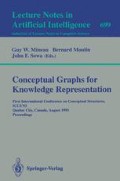Abstract
In the conventional knowledge based systems, there is a distinct separation between the domain knowledge and the inference engine that utilises these domain knowledge for problem solving. The knowledge acquisition process for engineering such a system is a major bottle-neck for the liberal exploitation of knowledge based systems. The author proposes to reduce, if not eliminate this bottle-neck by eliminating the distinction between the knowledge base and the inference engine, while maintaining the declarative and procedural nature of the domain knowledge. This is achieved with the development of an extended form of knowledge representation scheme, known as the Executable Conceptual Structures. This paper outlines two forms of Executable Conceptual Structures. They are the Actor Graphs and Problem Maps, respectively [1]. Actor Graphs are the atomic components of a larger and more complex structure called the Problem Maps. Actor Graphs represent only a single action, while the Problem Maps represent plans and associated strategic knowledge in the form of Conceptual Rules for plan selections and/or plan disambiguation during run time. Executable Conceptual Structures are the result of the merger of two fundamental principles, yet related in some ways. They are conceptual graphs [2] and the object oriented principles. The synthesis of the above two principles, enabled the development of an extended knowledge representation technique, well suited for representing both the declarative knowledge and its associated and/or related procedural knowledge. This paper also outlines two advancements requisite for the development of Executable Conceptual Structures: Intelligent Control Script and the Actor Paradigm. This paper further outlines the formal definition of these Executable Conceptual Structures in terms of lambda expressions. The development of Actor Graphs and Problem Maps are indeed a major breakthrough in themselves as well as for related research areas in Artificial Intelligence, mainly “automated programming”, “knowledge acquisition” and “expert systems” to outline a few. This paper concludes by outlining three limiting factors associated with the current implementation of the Executable Conceptual Structures.
Preview
Unable to display preview. Download preview PDF.
References
D. Lukose: Goal Interpretation As A Knowledge Acquisition Mechanism, PhD Thesis, Department of Computing and Mathematics, Faculty of Science, Deakin University, Geelong, Victoria, 3217.
J.F. Sowa: Conceptual Structures: Information Processing in Mind and Machine, Addison Wesley, Reading, Mass., 1984.
W.E. Gevarter: Artificial Intelligence, Expert Systems, Computer Vision, and Natural Language Processing, Noyes Publications, USA.
G. McCalla, N. Cercone: Guest Editors' Introduction: Approaches to Knowledge Representation, IEEE Computer, Vol. 16. No. 10, 1983.
T. Winograd: Frames and the Procedural Declarative Controversy, in Bobrow, D., and Collins, A., (Eds.), Representation and Understanding, Academic Press, 1975.
T.R. Gruber: The acquisition of strategic knowledge, Doctoral dissertation, Department of Computer and Information Science, University of Massachusetts, U.S.A., 1988.
T.R. Gruber: Automated Knowledge Acquisition for Strategic Knowledge, Machine Learning 4, Kluwer Academic Publishers, Boston, U.S.A., 1989, pp. 293–336.
O-J. Dahl, K. Nygoard: SIMULA — An Algol-based Simulation Language, CACM, Vol. 9, No. 9, 1966, pp. 671–678.
O. Nierstrasz: A survey of object-oriented concepts, in W. Kim and F. Lochovsky (Eds.), Object-Oriented Concepts, Databases and Applications, ACM Press and Addison-Wesley, 1989, pp. 3–21.
B.J. Garner, D. Lukose: Active Agent Paradigm for Knowledge Based Systems, in S. Ramani, R. Chandrasekaran, and K.S.R. Anjaneyulu (Eds.), Lecture Notes in Artificial Intelligence 444, Springer-Verlag, 1989.
M.L. Hines, T. Hines: Relationship Mapping: Conceptual Graphs to Object-Oriented, Proceedings of the Sixth Annual Conceptual Graphs Workshop, Eileen Way, (Ed.), Suny, Binghamton, July 11–13, 1991.
T.E. Nagle: Conceptual Graphs In An Active Agent Paradigm, Proceedings of the IBM Workshop on Conceptual Graphs, 18–20th August, 1986, Thornwood, USA.
B. J. Garner, D. Lukose: Goal Specification Graphs for Strategic Knowledge Acquisition, Proceedings of the Australian Workshop on Knowledge Acquisition for Knowledge Based Systems, Pokolbin, N.S.W., Australia, August 20–23, 1991.
R.H. Hartley: Representation of Procedural Knowledge for Expert Systems, Proceeding of the IEEE Conference on Artificial Intelligence Applications, December 11–13, Miami Beach, Florida.
R.E. Fikes, N.J. Nilsson: STRIPS: A New Approach to the Application of Theorem Proving to Problem Solving, Artificial Intelligence 2(3–4), 1971, pp. 189–208.
B.J. Garner, D. Lukose: Goal Interpretation as a Knowledge Acquisition Mechanism. in E. Balagurusamy (Ed.), Artificial Intelligence in Industry and Government, Macmillan India Limited, 1989, pp. 877–890.
B.J. Garner, D. Lukose: Strategic Knowledge Elicitation Utilising Goal Interpretation Methodology. in E. Balagurusamy and B. Sushila (Eds), Computer Systems and Applications: Recent Trends, Tata McGraw-Hill Publishing Company Limited, 1990, pp. 521–537.
D. Lui: Strategic Knowledge for the Identification and Construction of Goal States, M.Sc. Thesis, Department of Computing and Mathematics, School of Sciences, Deakin University, Geelong, Victoria, Australia, 3217, 1990.
B.J. Garner, D. Lukose: Building Expert Advisor Utilising Problem Map, Journal of Information Science and Technology, Tata McGraw-Hill Publishing Company Ltd., 1992.
B.J. Garner, D. Lukose: Knowledge Fusion, Proceedings of the Seventh Annual Workshop on Conceptual Graphs, Las Cruces, July, 1992.
J.E. Heaton: CGP User Guide, Department of Computer Studies, Loughborough University of Technology, England, United Kingdom, September 1992.
P. Kocura: Towards a Deep-Knowledge Semantics for Conceptual Graphs, in T.E. Nagle, J.A. Nagle, L.L. Gerholz, and P.W. Eklund (Eds.), Conceptual Structures: Current Research and Practice, Ellis Horwood, England, 1992.
Author information
Authors and Affiliations
Editor information
Rights and permissions
Copyright information
© 1993 Springer-Verlag Berlin Heidelberg
About this paper
Cite this paper
Lukose, D. (1993). Executable conceptual structures. In: Mineau, G.W., Moulin, B., Sowa, J.F. (eds) Conceptual Graphs for Knowledge Representation. ICCS 1993. Lecture Notes in Computer Science, vol 699. Springer, Berlin, Heidelberg. https://doi.org/10.1007/3-540-56979-0_12
Download citation
DOI: https://doi.org/10.1007/3-540-56979-0_12
Published:
Publisher Name: Springer, Berlin, Heidelberg
Print ISBN: 978-3-540-56979-4
Online ISBN: 978-3-540-47848-5
eBook Packages: Springer Book Archive

